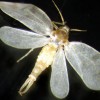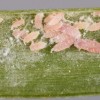 A new addition on the list of whitefly species found in Florida, Aleurodicus rugioperculatus Martin, was originally called the gumbo limbo spiraling whitefly, but is now named the rugose spiraling whitefly. Being a fairly new species to science – identified less than a decade ago, not much information is available about this pest. It is an introduced pest, endemic to Central America, and was reported for the first time in Florida from Miami-Dade County in 2009. Since then it has become an escalating problem for homeowners, landscapers, businesses, and governmental officials throughout the southern coastal counties of Florida. Feeding by this pest not only causes stress to its host plant, but the excessive production of wax and honeydew creates an enormous nuisance in infested areas. The presence of honeydew results in the growth of fungi called sooty mold, which then turns everything in the vicinity covered with honeydew black with mold. This 5-page fact sheet was written by Vivek Kumar, Cindy L. McKenzie, Catharine Mannion, Ian Stocks, Trevor Smith, and Lance S. Osborne, and published by the UF Department of Entomology and Nematology, October 2013.
A new addition on the list of whitefly species found in Florida, Aleurodicus rugioperculatus Martin, was originally called the gumbo limbo spiraling whitefly, but is now named the rugose spiraling whitefly. Being a fairly new species to science – identified less than a decade ago, not much information is available about this pest. It is an introduced pest, endemic to Central America, and was reported for the first time in Florida from Miami-Dade County in 2009. Since then it has become an escalating problem for homeowners, landscapers, businesses, and governmental officials throughout the southern coastal counties of Florida. Feeding by this pest not only causes stress to its host plant, but the excessive production of wax and honeydew creates an enormous nuisance in infested areas. The presence of honeydew results in the growth of fungi called sooty mold, which then turns everything in the vicinity covered with honeydew black with mold. This 5-page fact sheet was written by Vivek Kumar, Cindy L. McKenzie, Catharine Mannion, Ian Stocks, Trevor Smith, and Lance S. Osborne, and published by the UF Department of Entomology and Nematology, October 2013.
http://edis.ifas.ufl.edu/in1015
Tag: Ian Stocks
A Mealybug Phenacoccus multicerarii Granara de Willink (Hemiptera: Pseudococcidae) (EENY550/IN993)
 Florida Department of Agriculture and Consumer Services, Division of Plant Industry inspector Lisa Hassell collected the mealybug Phenacoccus multicerarii, a new continental record, from a retail nursery in Fernandina Beach (Nassau County, on 15 June 2011). On a return visit to the store, the mealybug was observed in high numbers on numerous host plants. Three days later, an additional find was made at a nursery in Apopka that had exchanged plant material with the nursery in Jacksonville. No further infestations were reported until October 2012, when a heavy infestation was discovered on a residential planting of coleus in Cooper City (Broward County). This mealybug was described in 2007 from a sample collected in Caracas, Venezuela, in 1949 from an unknown host (Granara de Willink and Szumik 2007). This 2-page fact sheet was written by Ian Stocks, and published by the UF Department of Entomology and Nematology, April 2013.
Florida Department of Agriculture and Consumer Services, Division of Plant Industry inspector Lisa Hassell collected the mealybug Phenacoccus multicerarii, a new continental record, from a retail nursery in Fernandina Beach (Nassau County, on 15 June 2011). On a return visit to the store, the mealybug was observed in high numbers on numerous host plants. Three days later, an additional find was made at a nursery in Apopka that had exchanged plant material with the nursery in Jacksonville. No further infestations were reported until October 2012, when a heavy infestation was discovered on a residential planting of coleus in Cooper City (Broward County). This mealybug was described in 2007 from a sample collected in Caracas, Venezuela, in 1949 from an unknown host (Granara de Willink and Szumik 2007). This 2-page fact sheet was written by Ian Stocks, and published by the UF Department of Entomology and Nematology, April 2013.
http://edis.ifas.ufl.edu/in993
The mexican lac scale Tachardiella mexicana (Comstock) (Hemiptera: Kerriidae) (EENY552/IN990)
 The Mexican lac scale is native to Mexico and Texas, but populations have been established in Florida. Adult female scales produce a high-domed ‘test’ or shell with four to six lobe-like projections that anchor the test to the plant surface. The test is hard and glossy with a reddish-orange tint around the edges, and darker toward the center. In some specimens, white string-like wax fiber extrusions project from the dorsum of the test, but these may break off. This 3-page fact sheet was written by Ian Stocks, and published by the UF Department of Entomology and Nematology, April 2013.
The Mexican lac scale is native to Mexico and Texas, but populations have been established in Florida. Adult female scales produce a high-domed ‘test’ or shell with four to six lobe-like projections that anchor the test to the plant surface. The test is hard and glossy with a reddish-orange tint around the edges, and darker toward the center. In some specimens, white string-like wax fiber extrusions project from the dorsum of the test, but these may break off. This 3-page fact sheet was written by Ian Stocks, and published by the UF Department of Entomology and Nematology, April 2013.
http://edis.ifas.ufl.edu/in990
Mealybug Vryburgia trionymoides (DeLotto) (Pseudococcidae) (EENY553/IN991)
 On several occasions in 2011, succulents for sale at retail stores in Florida were found with infestations of the mealybug Vryburgia trionymoides DeLotto. A traceback revealed that the succulents originated in California, where this mealybug is known as an occasional greenhouse pest. Specimens intercepted or found in retail stores often were well-hidden in the axillary region near the stem, making detection more challenging. An untreated infestation can kill a plant, there are no published reports of economic losses caused by this species. This 2-page fact sheet was written by Ian Stocks, and published by the UF Department of Entomology and Nematology, April 2013.
On several occasions in 2011, succulents for sale at retail stores in Florida were found with infestations of the mealybug Vryburgia trionymoides DeLotto. A traceback revealed that the succulents originated in California, where this mealybug is known as an occasional greenhouse pest. Specimens intercepted or found in retail stores often were well-hidden in the axillary region near the stem, making detection more challenging. An untreated infestation can kill a plant, there are no published reports of economic losses caused by this species. This 2-page fact sheet was written by Ian Stocks, and published by the UF Department of Entomology and Nematology, April 2013.
http://edis.ifas.ufl.edu/in991
Tuttle mealybug Brevennia rehi (Pseudococcidae) (EENY551/IN989)
 The Tuttle mealybug, Brevennia rehi (Lindinger), is a pest of many grass species and occurs nearly worldwide, especially where rice and sugarcane are grown. Because Bermuda and zoysia are important lawn grasses, especially in the southern United States, infestation by Tuttle mealybug should be considered whenever dieback is noticed, especially if the grass blades show white wax or are sticky from honeydew secretion. Both Bermuda and zoysia lawns are commonly installed as sod or plugs, which provide a ready route for the spread of infestations should the pest control practices of the grower fail to maintain a pest-free production environment. This 3-page fact sheet was written by Ian Stocks, and published by the UF Department of Entomology and Nematology, April 2013.
The Tuttle mealybug, Brevennia rehi (Lindinger), is a pest of many grass species and occurs nearly worldwide, especially where rice and sugarcane are grown. Because Bermuda and zoysia are important lawn grasses, especially in the southern United States, infestation by Tuttle mealybug should be considered whenever dieback is noticed, especially if the grass blades show white wax or are sticky from honeydew secretion. Both Bermuda and zoysia lawns are commonly installed as sod or plugs, which provide a ready route for the spread of infestations should the pest control practices of the grower fail to maintain a pest-free production environment. This 3-page fact sheet was written by Ian Stocks, and published by the UF Department of Entomology and Nematology, April 2013.
http://edis.ifas.ufl.edu/in989